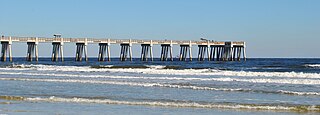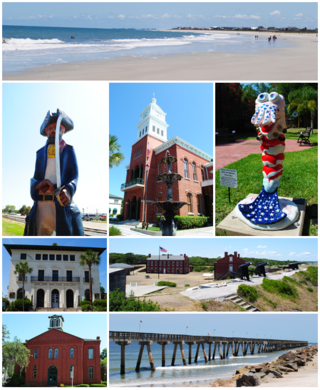
Jacksonville is the most populous city proper in the U.S. state of Florida, located on the Atlantic coast of northeastern Florida. It is the seat of Duval County, with which the City of Jacksonville consolidated in 1968. It is the largest city by area in the contiguous United States as of 2020.

Jacksonville Beach is a coastal resort city in Duval County, Florida, United States. It was incorporated on May 22, 1907, as Pablo Beach, and changed to Jacksonville Beach in 1925. The city is part of group of communities collectively referred to as the Jacksonville Beaches. These communities include Mayport, Atlantic Beach, Neptune Beach, and Ponte Vedra Beach. When the city of Jacksonville consolidated with Duval County in 1968, Jacksonville Beach, together with Atlantic Beach, Neptune Beach, and Baldwin, voted to retain their own municipal governments. As a result, citizens of Jacksonville Beach are also eligible to vote in mayoral election for the City of Jacksonville. As of the 2020 US census, Jacksonville Beach had a total population of 23,830, up from 21,362 at the 2010 census. It is part of the Jacksonville, Florida Metropolitan Statistical Area.

Fernandina Beach is a city in northeastern Florida and the county seat of Nassau County, Florida, United States. It is the northernmost city on Florida's Atlantic coast, situated on Amelia Island, and is one of the municipalities comprising Greater Jacksonville. The area was first inhabited by the Timucuan Indian people. Known as the "Isle of 8 Flags", Amelia Island has had the flags of the following nations flown over it: France, Spain, Great Britain, Spain (again), the Republic of East Florida (1812), the Republic of the Floridas (1817), Mexico, the Confederate States of America, and the United States.

Johnnetta Betsch Cole is an American anthropologist, educator, museum director, and college president. Cole was the first female African-American president of Spelman College, a historically black college, serving from 1987 to 1997. She was president of Bennett College from 2002 to 2007. During 2009–2017 she was Director of the Smithsonian Institution's National Museum of African Art. Cole served as the national chair and 7th president for the National Council of Negro Women from 2018 to 2022.
Anna Madgigine Jai Kingsley, born Anta Madjiguène Ndiaye, also known as Anna Kingsley, Anta Majigeen Njaay or Anna Madgigine Jai, was a West African from present-day Senegal, who was enslaved and sold in Cuba, probably via the slave pens on Gorée Island. In Cuba she was purchased, as wife, by plantation owner and slave trader Zephaniah Kingsley. After his death, she became a planter and slave owner in her own right, as a free Black woman in early 19th-century Florida.
Abraham Lincoln Lewis (1865–1947) was an influential American businessman who founded the Afro-American Life Insurance Company in Jacksonville, Florida and became the state's first African-American millionaire. He also founded the National Register-listed community of American Beach, founded as a prestigious vacation spot for African Americans during the period of racial segregation.
The Afro-American Life Insurance Company was a historic business based in Jacksonville, Florida. It was founded in 1901 by Abraham Lincoln Lewis and his business associates. The company specialized in helping Black Americans obtain life insurance and mortgages.

Lincolnville Historic District is a neighborhood in St. Augustine, Florida established by freedmen following the American Civil War and located on the southwest peninsula of the "nation's oldest city." It was designated as an historic district in 1991 and listed on the National Register of Historic Places. Originally recorded with 548 contributing buildings, the district is bounded by Cedar, Riberia, Cerro and Washington streets and DeSoto Place.

Kingsley Plantation is the site of a former estate on Fort George Island, in Duval County, Florida, that was named for its developer and most famous owner, Zephaniah Kingsley, who spent 25 years there. It is located at the northern tip of Fort George Island at Fort George Inlet, and is part of the Timucuan Ecological and Historic Preserve managed by the U.S. National Park Service. Kingsley's house is the oldest plantation house still standing in Florida, and the solidly-built village of slave cabins is one of the best preserved in the United States. It is also "the oldest surviving antebellum Spanish Colonial plantation in the United States."

The Lewis Mausoleum is a historic mausoleum in Jacksonville, Florida. It is located in Memorial Cemetery, at the junction of Edgewood Avenue and Moncreif Road. On October 24, 1997, it was added to the U.S. National Register of Historic Places.
MaVynee Betsch, christened Marvyne Elisabeth Betsch, was an American environmentalist and an activist. She was better known as The Beach Lady, because she spent the better part of her adult life educating the public on the black history and environmental importance of American Beach. Born in Jacksonville in 1935, Betsch lived at American Beach on Amelia Island, Florida, the African-American Hyannis port, where the crème de la crème of black society came to relax in the Jim Crow South. MaVynee’s millionaire grandfather, Abraham Lincoln Lewis, founded the beach, and she was raised in luxury as a member of the African-American upper class. Her wealth and privilege vanished after she later gave away her entire fortune to environmental causes. Afterwards, she slept on American Beach in a chaise longue for the rest of her life.

The Jacksonville Fire Museum is part of the Jacksonville Fire and Rescue Department's Fire Prevention Division. The museum is home to artifacts detailing the history of the fire service not only in Jacksonville, but the entire state of Florida. Exhibits include photos from and a diorama of the Great Fire of 1901, a fully restored 1902 LaFrance horse-drawn fire engine, and a 1926 American LaFrance fire engine.

The Herndon Home is a historic house museum and National Historic Landmark at 587 University Place NW, in Atlanta, Georgia. An elegant Classical Revival mansion with Beaux Arts influences, it was the home of Alonzo Franklin Herndon (1858-1927), a rags-to-riches success story who was born into slavery, but went on to become Atlanta's first black millionaire as founder and head of the Atlanta Life Insurance Company. The house was designed by his wife Adrienne, and was almost entirely built with African-American labor. The house was declared a National Historic Landmark in 2000, and had previously been declared a "landmark building exterior" by the city of Atlanta in 1989.
The following is an alphabetical list of articles related to the U.S. state of Florida.

Kathryn Abbey Hanna Park is a 1.5-mile (2.4 km) public beach and city park in Jacksonville, Florida. It is located at Mayport in the Jacksonville Beaches area. It consists of 447 acres (1.81 km2) of mature coastal hammock, which is increasingly rare along Florida's heavily developed Atlantic coast.

Patrick Henry Chappelle, was an American theatre owner and entrepreneur, who established and ran The Rabbit's Foot Company, a leading traveling vaudeville show in the first part of the twentieth century. He became known as one of the biggest employers of African Americans in the entertainment industry, with multiple tent traveling shows and partnerships in strings of theaters and saloons. Chappelle was described at that time as the "Pioneer of Negro Vaudeville" and "the black P. T. Barnum," and was the only African American to fully operate a traveling show solely composed of African-American entertainers.

Frank Bertran Butler (1885–1973) was an American businessman who established a beach resort for African Americans in northeast Florida during the segregation era. He worked in Fernandina Beach, St. Augustine, and then St. Augustine's Lincolnville neighborhood where he established his own market as well as a real estate business. He acquired land on Anastasia Island stretching between the Atlantic Ocean and the Matanzas River on which he established a beach area resort open to African Americans. The Tampa Times reported it to be the only beach open to them between the Jacksonville area and Daytona Beach during segregation. It became known as Butler Beach. The unincorporated community and a park in it are named for him.

During the decades of segregation in the United States, African Americans established various resorts. The resorts were self-contained commercial establishments. Varying resort accommodations included rooms for rent, meals and fine food, cocktail bars, dancing, sporting facilities, and beaches. Also in some cases entire communities were known as resort areas for African Americans. The Negro Motorist Green Book helped guide African Americans to accommodating and safe places, including Idlewild, Michigan, which was among the most well known.






















